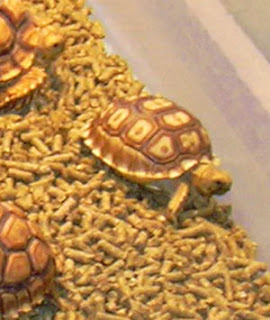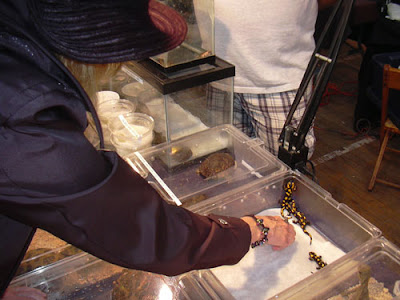I doodled this on my pad
while I was gathering some notes for this blog and thought I’d share it here
with you.
I'm actually making light of a very
serious issue which is that no matter how good an actor or actress this
amphibian is, he (or she) is only given bit parts. It’s very slimy treatment if
you ask me…even for salamanders which are slimy to begin with!
OK, enough of with the
shenanigans, allow me to introduce you (for real this time)
to the star of the hour, The Northern Two-Lined Salamander (Eurycea bislineata).
If you’re having trouble
pronouncing “Eurycea bislineata” just remember it sounds a lot like “Eurycea
bislineata.”
Not helpful? I guess you can
see why I never became a teacher!
Anyway, I have found these
to be some of the speediest salamanders encountered in the Northeast. They’ll
wriggle faster than your eyes can follow into the safety of a nearby creek or stream.
When I was a small boy my
friends and I called these sals “the cool yellow ones!” They somehow seemed more
alert, elusive and exotic than their drabber colored and more accessible
woodland cousins. We would have to get on our bicycles and peddle a good half
mile or so to a brook that ran behind the local tennis courts to find them. On
a productive day after a few minutes of flipping over smooth stones we’d see a
flash of gold and catch a glimpse of a fleeing two-lined. It was rare that we were
ever were able to put our hands on one though because they were just that quick!
It was probably for the better though
because none of these delicate salamanders appreciate being handled no matter
how gentle you think your being.
Are we all done? Oh, that’s
right! You might like to know something about this amphibian’s habits and
haunts! I got so sidetracked with the reminiscing that I forgot I was also
supposed to be supplying you with some worthwhile information as well!
The Northern Two-Lined
Salamander is a very skinny critter measuring about 2 ½ to 3 ½ inches long. They range from northern Virginia and Ohio up
to Southern Quebec. Like the red-backs discussed in Blog 8, “Here Comes The
Plethodons!” It belongs to the diverse group of lungless salamanders meaning
that they breathe entirely through their skin and the lining of their mouth.
They are found in and around
highly oxygenated rock-bottomed brooks, springs, seepages, in woodland swamps
and on river floodplains. They less commonly live under rotting logs in damp
forests a good distance from running water.
I have personally found them
on the pebble strewn shores of kettle lakes and on the banks of the Pocono
creek! If you have an unpolluted stream nearby go run out and turn over a few
flat stones . . . you’ll probably see
one! Take a photograph of your find and post it here! I’ love to see it!!
What? You have better things
to do with your spare time? OK, then just skip it and keep on reading!
Here is a great little
description about E. bislineata from a book published in 1930 about pond life.
The author, like me, was impressed with their agility;
“The
adults hide beneath flat stones in the water-soaked mud and sand of
brook-sides, slithering and jumping out with amazing rapidity when disturbed.
The larvae, distinguishable by their gills, grow nearly as long as the adults
and stay in the same places, whence they dash out with flash-like suddenness
when the stones are moved”
“Whence,” how cool is that!?
Who uses “whence” anymore in 2013?
I also want to share this
nice little doodle from the book! I guess I’m doing this without permission so
I my apologies to the publisher “G.P. Putnam’s Sons,” please don’t sue me!
In the Poconos the two-Lines
mate in the fall and the following spring, as late as mid-July, the female
deposits 12 to 100 eggs on the underside of a submerged rock. She guards her brood for 4-10 weeks until they
hatch into aquatic larvae.
 |
| Typical 2-Lined Habitat |
For some strange
reason, in all the years I have been traipsing around the New Jersey and Pocono
wilds I have never come upon a female with eggs. Maybe that’s because my
encounters are always along the shoreline and they “nest” in deeper parts of
the water? Who knows! Just another thing to ponder over my morning coffee I
guess!
Here is the best photo I have managed to take to date of this salamander in its larval form. Not great I know but my little Nikon has trouble photographing through the surface of a gurgling creek.
Adult Two-Lineds feed on granola
bars, tofu and fruit salad but only if it’s certified organic!
Huh?
I just wanted to make sure
you were still with me and hadn’t trailed off or something. You have to really
dig critters to be hanging in there!
OK, so less appetizing but
much more accurate; adult Eurycea bislineatas feed on beetles, spiders, sow bugs
(same as pill bugs), ticks, mayflies, springtails (same as snow fleas), thrips and a host of other tiny
insects and worms. Thrips, by the way, also called “corn lice” are minute
1 millimeter long sucking insects. I’m sharing that with you because I didn’t
know what they were so I thought you might not either.
Well, guess what? You made
it through another Kieran’s Critters! You are to be commended for your
intrepidness and spirit of adventure! Any comments, ideas, suggestions, critter
stories or imaginary words are always welcome. If you have any complaints at
all about anything I stated here please write them out in small 1 to 2 syllable
words on the back of a $50 bill and send them to: Mr. E. Bislineata, care of
Kieran Vogel at 123 Lois Lane, Somewhere, PA 314159.
Thanks again for reading!
Merry meet, merry part and merry meet again!


































































